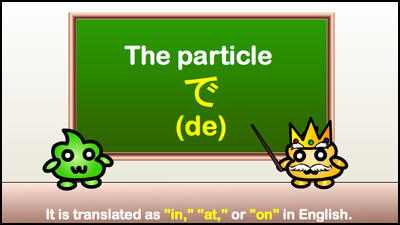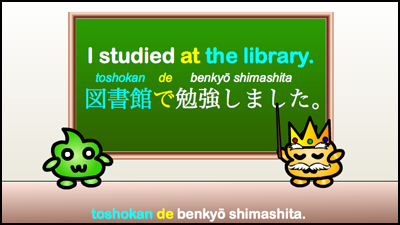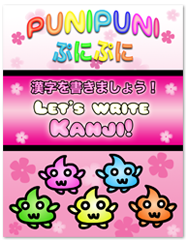☆ PuniPuni Youtube ☆
Japanese Grammar Lesson 10: The Particle で (de) – Review Notes
Today we learned how to use the Japanese particle で (de) to indicate the place at which an action or event takes place. We learned that it can be used like “at” or “in” is used in English. In this review, we will talk about some other uses of the particle で.
………………………………………………………………………………..
Using the particle で (de) as “at” or “in”:

★ The Japanese particle で (de) is used to indicate the place at which an action or event takes place. It is translated as “at,” “in,” or “on” in English.
★ The particle で comes after the place (noun) and before the action (verb) in the sentence.

★ In this example, で means at. Notice that the word order is different from English. The place name goes first (library), followed by the particle で (at), followed by the verb (studied).
図書館で勉強しました。
toshokan de benkyō shimashita.
I studied at the library.

★ In this example, で means in. Notice that the word order is different from English. The place name goes first (pool), followed by the particle で (in), followed by the verb (swam).
プールで泳ぎました。
pūru de oyogimashita.
I swam in the pool.
…………………………………………………………………………………
Using the particle で (de) to indicate means:
★ The particle で can also be used to indicate means, method, or instruments. It translates into “by”, “with”, “in,” “by means of”, etc.
…………………………………………………………………………………
Example 1:
自転車で学校に行きます。
jitensha de gakkō ni ikimasu.
I go to school by bike.
…………………………………………………………………………………
Example 2:
日本語で話して下さい。
nihongo de hanashite kudasai.
Please speak in Japanese.
…………………………………………………………………………………
Using the particle で (de) to indicate total:
★ When the particle で is placed after a quantity, time, or amount of money, it indicates a total or an extent.
…………………………………………………………………………………
Example 1:
全部で五千円です。
Zenbu de gosen en desu.
It costs 5,000 yen in total/altogether.
…………………………………………………………………………………
Using the particle で (de) to indicate time:
★ The particle で can be used to indicate time spent for something. It translates to “in”or“within.”
…………………………………………………………………………………
Example 1:
三時間で行けます。
Sanjikan de ikemasu.
We can get there in three hours.
…………………………………………………………………………………
Using the particle で (de) for required cost:
★ The particle で can be used to indicate cost. It translates to “for,” “at,” etc.
…………………………………………………………………………………
Example 1:
この本を五百円で買いました。
kono hon o gohyaku en de kaimashita.
I bought this book for 500 yen.
…………………………………………………………………………………
Using the particle で (de) to indicate scope:
★ The particle で can be used like “in,” “within,” or“among” to indicate scope.
…………………………………………………………………………………
Example 1:
世界で一番好きです。
Sekai de ichiban suki desu.
I love you more than anything in the world.
…………………………………………………………………………………
Using the particle で (de) to indicate material:
★ The particle で can be used to tell what something is made of.
…………………………………………………………………………………
Example 1:
このつくえは木でできています。
Kono tsukue wa ki de dekiteimasu.
This desk is made of wood.
…………………………………………………………………………………
Using the particle で (de) to indicate cause:
★ The particle で can indicate a casual reason or motive for an action or occurrence. It translates into “due to”, “because of”, “owing to”, etc.
………………………………………………………………………………..
Example 1:
風邪で学校を休んだ。
Kaze de gakkō o yasunda.
I was absent from school due to a cold.
………………………………………………………………………………..
Conclusion:
Today we learned about the Japanese particle で. There are many ways to use this particle, but you don’t have to remember them all right away.
The most basic one to know is the one that we covered in the video, when で is indicating a place where action occurs. In this case it is translated as “at,” “in,” or “on” (◕ω◕)♪
………………………………………………………………………………..
Get Japanese dictionary!
Do you want to know a lot of Japanese words? I recommend you to get a dictionary!
If you have dictionary, you can always look up new Japanese words\(◕ω◕)/♥
………………………………………………………………………………..
………………………………………………………………………………..
Do you want a Japanese tutor?
Take Japanese Skype Lessons with Professional Japanese Teachers on kakehashijapan.com!
………………………………………………………………………………..
















19 comments
would it be correct to write:
私は12時15分で起きます.
I am trying to say, “I woke up at 12:15”.
Comment by Alex on 04/27/2013 at 3:17 pmIt’s almost correct, but there are a few mistakes (◕ω◕)☆ You can say: 私は12時15分に起きました.
You should use time particle に instead of で in this sentence. Click here to find out more about the time particle に!
Also, if you want to say you “woke” up, you must use the past tense of the verb. Click here to learn more about how to change a verb into past tense!
Comment by PuniPuni on 04/27/2013 at 11:42 pmIn “このつくえは木でできています。”
Why use “できています” instead of “できました”?
In “三時間で行けます。”
Comment by Jay on 08/09/2013 at 12:17 pmIs the plain form of the verb “行ける”? What does it mean?
If I want to say “I went to his house”
Comment by jessa on 02/05/2014 at 9:43 pmshould I say “Watashi wa kare no inu de ikismashita”
You can say “Watashi wa kare no ie ni ikimashita” – I went to his house. (◕ω◕)♥ See this lesson about the particle “ni”: http://www.punipunijapan.com/japanese-particle-ni-e/
Comment by PuniPuni on 02/09/2014 at 5:36 pmHi, PuniPuni-san 🙂
I would just like to say, out of all the sites I’ve trawled through to learn Japanese – this is by far the best. You present the information concisely, in easy to understand ways, provide plenty of examples (and extra vocab!) cater for people who are interested in Kanji (and those who are not quite yet)and manage to set the lessons out in ways that build up the Japanese we understand instead of just dumping it all on us at once. You site is so easily accessible and we can even get feedback from you without paying money! Kudos to you x 1000000000 XD
You are the best!
Comment by Grace on 05/02/2014 at 5:17 amThank you very much for your kind words! We are happy that we are able to help you and many others to learn Japanese! (>ω<)♥
Comment by PuniPuni on 05/07/2014 at 5:57 amHow do I say : “We can get there in a week”. Or you know, “we arrive in a week.” Does it work with the で paricule?
Comment by 餅 on 05/08/2014 at 1:54 pmYou would not use the particle で for this unless it literally takes a week to travel to wherever you are going.
Although “We can get there in a week” is structurally similar in English with our example “We can get there in three hours” I think the nuance is different if you intend this to be similar in meaning to “we arrive in a week.”
To say “we arrive in a week” in Japanese, you would use the time particle に (ni): 一週間後に着きます。(isshūkan go ni tsukimasu.)
Learn more about the time particle に (ni) here: http://www.punipunijapan.com/time-particle-ni/
Comment by PuniPuni on 05/09/2014 at 8:33 amHi there, when saying “I got to school by bike” it says the proper translation is “jitensha de gakko ni ikimasu” why would we use ikimasu as opposed to ikimashita which is past tense? Thanks a lot for any help, really appreciating/loving the site!
Comment by Cole on 05/09/2014 at 9:35 pmI am glad you are finding our site useful! I think you may have misread the example. It says: “I go to school by bike” not “I got to school by bike.” Since it is present tense, we use ikimasu. (◕ω<)☆
Comment by PuniPuni on 05/14/2014 at 4:52 amExcuse me is this right? スプーンとプレートで食べます “i eat by using spoon and plate
Comment by Firman on 05/24/2014 at 11:34 pmIt’s alright, but it is better to use the Japanese word for plate: お皿 (osara) instead of プレート (Japanese people don’t use this katakana word for “plate” very much.)
Comment by PuniPuni on 05/27/2014 at 7:01 amhi
Comment by Noman on 07/25/2014 at 4:08 amdoesn’t kaze mean wind
Yes, 風 (kaze) means “wind.” But, 風邪 (kaze) means “a cold (illness).” The kanji is a little different although the reading is the same.
Comment by PuniPuni on 08/01/2014 at 8:06 amCan you please tell me what the difference is between いきます and いけます?
Comment by Spensyr on 10/21/2014 at 8:52 pm行きます(いきます)is the normal present/future tense of the verb “to go.” It means “go” or “will go.”
For example 学校に行きます。(“I go to school,” or “I will go to school.”)
行けます(いけます)is the potential form of the verb “to go.” It means “can go.”
Comment by PuniPuni on 10/22/2014 at 7:34 amFor example 学校に行けます。(“I can go to school.”)
Hello PuniPuni!
Comment by shinineko on 12/28/2014 at 4:04 amI want to say ‘the cat loves snow’ or ‘the cat is walking through the snow’. Can I use ‘de’ for the second one? And if yes, can you please tell me how to use it in this sentence? :3 That would be really awwsome~
the cat loves snow: 猫は雪が大好きです。(neko wa yuki ga daisuki desu)
Comment by PuniPuni on 01/06/2015 at 7:31 amthe cat is walking through the snow: 猫は雪の中を歩いています。(neko wa yuki no naka o aruiteimasu)
For “through” you use the particle を (o) instead of で (de).